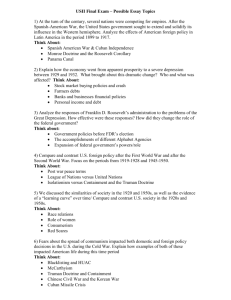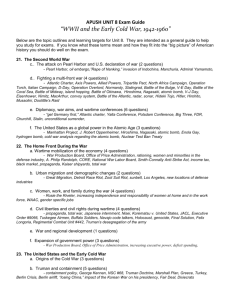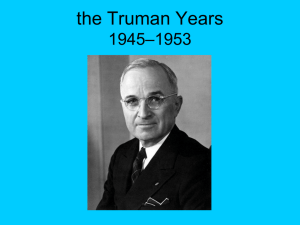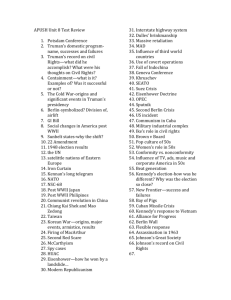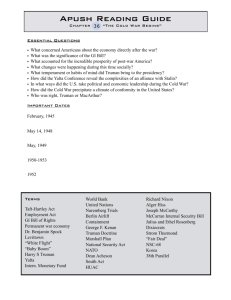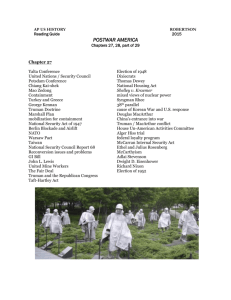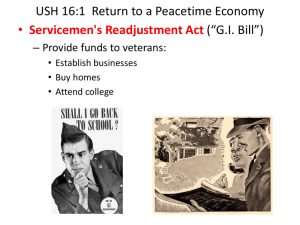GUIDING QUESTION To what extent did the Second World War
advertisement
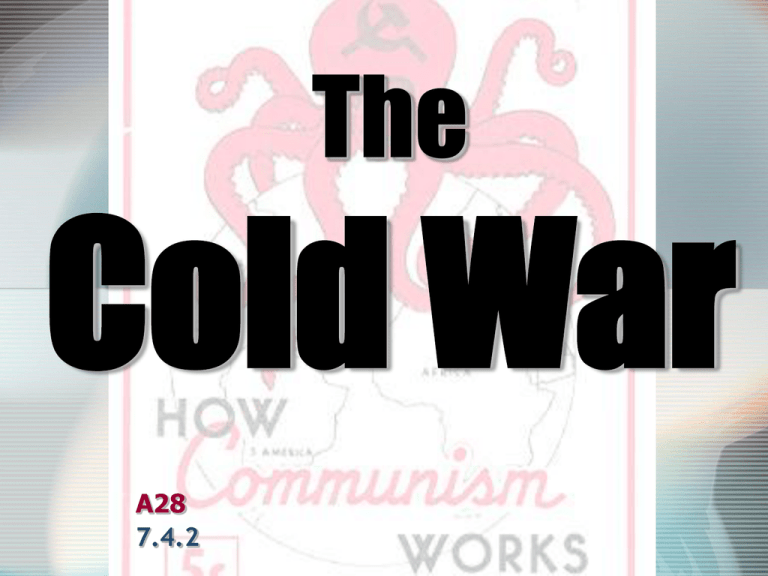
The Cold War A28 7.4.2 GUIDING QUESTION Why did relations between the United States and the Soviet Union devolve into a Cold War after the Second World War? GUIDING QUESTION Analyze the success and failures of the United States Cold War policy of containment during the period 1945-1953 in the following: Europe, Asia, Middle East, Latin America. ORIGINS OF THE COLD WAR War Aims and Postwar Diplomacy ORIGINS OF THE COLD WAR Basic incompatibility of economic and political systems History of discord and mistrust Western response to Bolshevik Revolution US recognition of the Soviet Union Nazi-Soviet Nonaggression Pact ORIGINS OF THE COLD WAR WWII Alliance of Britain and U.S. with Soviet Union was pragmatic “marriage of convenience” to defeat Germany 1. Lack of trust of Stalin. unified wartime command atomic bomb 2. Soviets believed western allies not sharing load 3. Soviet mistreatment of eastern Europeans during WWII ORIGINS OF THE COLD WAR: Wartime Diplomacy “Big Three” Allied leaders were consistently unable to resolve their basic disagreements over the structure of post-war Europe Tehran Conference (November 1943) U.S. and Britain would open a second front within six months Allies would create a post-war international organization Stalin, Roosevelt & Churchill at Tehran, 1943 ORIGINS OF THE COLD WAR : Wartime Diplomacy Yalta Conference (January-February 1945) Loose set of principles that avoided the most divisive issues. Division of Germany (and Berlin) into four “zones of occupation”; Reunification of Germany at a future date; process not specified Soviets would enter Pacific war within 3 months after Germany had been defeated United Nations Poland – free elections at some unspecified date after the war “the holding of free and unfettered elections as soon as possible on the basis of universal suffrage and secret ballot" Churchill, Roosevelt and Stalin at Yalta, February 1945 ORIGINS OF THE COLD WAR : Wartime Diplomacy San Francisco Conference - United Nations Formed (April 1945) Security Council 11 members Permanent seats with veto power for U.S., Britain, France, China and USSR General Assembly Secretariat Secretary-General International Court of Justice ORIGINS OF THE COLD WAR : Wartime Diplomacy Potsdam Conference (July-Aug. 1945) Reparations: Stalin allowed to take 25% of West German industry Nazi leaders: to be tried as war criminals at Nuremberg Poland: Free elections Japan: Unconditional surrender Korea: to be temporarily divided Truman’s attitude Atomic bomb Churchill, Truman and Stalin at Potsdam ORIGINS OF THE COLD WAR: Causes of Cold War Soviets the main cause (Original U.S. view) Aggressive policies of expansion (in eastern Europe) and violation of Yalta agreements U.S. the main cause (Revisionist interpretation) By insisting that entire world be open to American trade and influence (capitalist expansionism & internationalism) Neither/Both the cause (post-revisionist Could the Cold War have been avoided? How? interpretation) Two most powerful nations in world bound to clash Through ignorance and misconceptions, both countries helped to create an atmosphere of tension and suspicion that touched off the Cold War TRUMAN AND CONTAINMENT IN EUROPE GUIDING QUESTION Analyze the success and failures of the United States Cold War policy of containment during the period 1945-1953 in Europe. B. TRUMAN AND CONTAINMENT IN EUROPE President Harry S Truman Poland Soviet “satellites” "Iron Curtain" - Churchill (March 1946) Containment Doctrine George Kennan (more economic/diplomatic than military) Truman Doctrine (1947) Greece & Turkey Significance (end isolationism, Korea, Vietnam) George Kennen Copyright 1997 State Historical Society of Wisconsin ( Churchill & Truman, "Iron Curtain Speech," March 5, 1946 (Harry S. Truman Library) B. TRUMAN AND CONTAINMENT IN EUROPE The Marshall Plan (1947) George C. Marshall National Security Act of 1947 Atomic Energy Commission Department of Defense Central Intelligence Agency National Security Council B. TRUMAN AND CONTAINMENT IN EUROPE Berlin Blockade (June 1948) new West German Republic Berlin Airlift (June 1948summer 1949) Cold War Division of Germany B. TRUMAN AND CONTAINMENT IN EUROPE North Atlantic Treaty Organization (NATO) Warsaw Pact (1955) (April 1949) Purpose significance "trouble spots" appeared - map from Time Magazine, May 1945 THE COLD WAR IN ASIA 1949-1954 GUIDING QUESTION Analyze the success and failures of the United States Cold War policy of containment during the period 1945-1953 in Asia. THE COLD WAR IN ASIA U.S. Ambassador Patrick Hurley, Chiang Kai-shek & Mao Zedong, 1945 Chinese Civil War (1927-1950) Nationalists (Kuomintang) Jiang Jieshi (Chiang Kai-Shek) Communists - Mao Zedong Truman administration “loses” China (1949) Taiwan “one China” policy Soviet A-bomb (Aug. 1949) NSC-68 (April 1950) Communist Revolution in China Soldiers of the victorious People’s Liberation Army entering Beijing, June 1949. THE COLD WAR IN ASIA Korean War (1950-1953) Gen. Douglas MacArthur Cold War significance Korean War - Phases 1 & 2 (June-November 1950) - The Martin letter Korean War Phases 3 & 4 (Nov. 1950-April 1951) Korean War American troops advancing in Korean War Fighting with the 2nd Inf. Div. north of the Chongchon River, Sfc. Major Cleveland, weapons squad leader, points out Communist-led North Korean position to his machine gun crew. Nov. 20, 1950 > > > Asia After World War II COLD WAR IN ASIA: IMPACT OF THE KOREAN WAR • Korea • • • • • • Soviets UN Asia Japan Vietnam U.S. (at home) U.S. Defense Spending, 1940-1964 (in constant 1975 dollars) COLD WAR IN ASIA & THE ENTIRE PLANET Hydrogen bomb (H-bomb) Mushroom cloud from hydrogen bomb on Bikini atoll DOMESTIC POST-WAR ADJUSTMENTS "Saturday afternoon street "Saturday afternoon street scene“, scene" Welch, W. Va., August 1946 DOMESTIC POST-WAR ADJUSTMENTS Reconversion Election of 1948 Presidential Election of 1948 FIGHTING COMMUNISM AT HOME The Red Scare and McCarthyism THE RED SCARE AND McCARTHYISM Loyalty checks (begun in 1947) House Un-American Activities Committee “The Hollywood 10” Hollywood Ten (with lawyers) (HUAC) THE RED SCARE AND McCARTHYISM Alger Hiss Whittaker Chambers Richard M. Nixon President Truman shakes the hand of Alger Hiss, UN Conference, June 1945 Hiss Called to Testify before HUAC, 1949 Chambers Makes Sensational Charges in Hiss Case. Acme. 1948 Nixon Pursues Hiss THE RED SCARE AND McCARTHYISM McCarran Internal Security Act Klaus Fuchs Julius and Ethel Rosenberg (1950) (convicted of nuclear espionage in 1951) Julius Rosenberg emerging after his conviction for espionage in 1951 Ethel Rosenberg left being escorted to another day in her federal espionage trial THE RED SCARE AND McCARTHYISM Joseph McCarthy (Feb. 1950) Army-McCarthy Hearings (1954) Dwight D. Eisenhower McCarthy demonstrating Communist subversion in the U.S., 1950 Joseph McCarthy and Aide Roy M. Cohn. 1954 Bomb Shelter Duck and Cover Films Reflect Cold War Themes? FOREIGN AFFAIRS UNDER EISENHOWER FOREIGN AFFAIRS in the 50s: CONTAINMENT WITH AN AWARENESS OF LIMITATIONS John Foster Dulles “roll back” massive retaliation brinkmanship “more bang for the buck” Eisenhower and Dulles Confer. 1954 FOREIGN AFFAIRS in the 50s: CONTAINMENT WITH AN AWARENESS OF LIMITATIONS Thirty-eighth parallel Ho Chi Minh Dien Bien Phu Geneva Accords Ngo Dinh Diem Ike Greets Diem, 1957 FOREIGN AFFAIRS in the 50s: CONTAINMENT WITH AN AWARENESS OF LIMITATIONS Zionists Shah of Iran Gamal Abdel Nasser Suez Crisis Israel, the Middle East and the Suez Crisis, 1956 FOREIGN AFFAIRS in the 50s: CONTAINMENT WITH AN AWARENESS OF LIMITATIONS Fidel Castro third World Fidel Castro at Harvard 1959 Nikita S. Khrushchev and Fidel Castro. United Nations. 1960 FOREIGN AFFAIRS in the 50s: CONTAINMENT WITH AN AWARENESS OF LIMITATIONS Hungarian Revolution Nikita Khrushchev U-2 U-2. 1978 Eisenhower, Khrushchev, and wives at a state dinner in 1959. U-2 Pilot Francis Gary Powers at Hearing. 1962 FOREIGN AFFAIRS in the 50s: CONTAINMENT WITH AN AWARENESS OF LIMITATIONS “military-industrial complex” GUIDING QUESTION ● How and for what reasons did U.S. foreign policy change between 1920 and 1941? (To what extent did the United States adopt an isolationist policy in the 1920s and 1930s?) GUIDING QUESTION To what extent did the Second World War bring about lasting change in the American society, economy and government? Sources National Archives and Records Administration American Journey Online http://www.wadsworth.com/history_d/special_features/image _bank_US/1946_1954.html Teaching Politics–Rutgers U. http://teachpol.tcnj.edu/amer_pol_hist/_browse1950.htm & http://teachpol.tcnj.edu/amer_pol_hist/_browse2000.htm http://us.history.wisc.edu/hist102/photos/html/sindex.html Brinkley, American History: A Survey 10e & 11e [Instructors Resource] Faragher, Out of Many, 3rd Ed.; http://wps.prenhall.com/hss_faragher_outofmany_ap/ Divine, America Past and Present Revd 7th Ed. Cayton, America: Pathways to the Present (2003) Nash, The American People 6e, http://wps.ablongman.com/long_nash_ap_6/0,7361,592970,00.html Roark, American Promise 3e from http://www.bedfordstmartins.com/mapcentral J. Jones, P. Wood, et al, Created Equal:, Kennedy, American Pageant 13e [History Companion CD] http://wps.ablongman.com/long_jones_ce_1/0,7283,494555-,00.html


